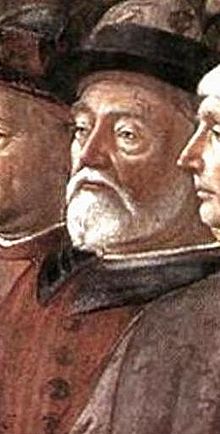Yohanes Argiropoulos
Yohanes Argiropoulos (bahasa Yunani: Ἰωάννης Ἀργυρόπουλος Ioannis Argyropoulos; bahasa Italia: Giovanni Argiropulo; nama belakang juga disebut Argyropulus, or Argyropulos, atau Argyropulo; s. 1415 – 26 Juni 1487) adalah seorang pengajar, filsuf dan humanis, salah satu cendekiawan Yunani yang mempelopori kebangkitan pemakaian klasik di Italia pada abad ke-15.[10] Ia menterjemahkan karya-karya filsafat dan teologi Yunani ke dalam bahasa Latin selain membuat karya-karya retorika dan teologi buatannya sendiri. Ia datang ke Italia untuk menghadiri Konsili Firenze pada 1439–44, dan kembali ke Italia usai kejatuhan Konstantinopel, mengajar di Firenze (di Studium Firenze) pada 1456–70 dan di Roma pada 1471–87.[6]
| John Argyropoulos | |
|---|---|
 Yohanes Argiropoulos digambarkan oleh Domenico Ghirlandaio pada tahun 1481 dalam Vokasi Para Rasul fresko di Kapel Sistina, Roma.[1][2][3][4] | |
| Lahir | Ioannis Argyropoulos s. 1415 Konstantinopel, Kekaisaran Bizantium |
| Meninggal | 1487 Firenze, Republik Firenze |
| Kebangsaan | Yunani[5] |
| Pendidikan | Universitas Padua (Theol. Dr., 1444) |
| Era | Filasat Abad Pembaharuan |
| Kawasan | Filsafat Barat |
| Aliran | Filsafat Abad Pembaharuan Aristotelianisme |
| Institusi | Universitas Konstantinopel (1448–1452)[6] Neoplatonic Florentine Academy (1456–70)[6] |
Minat utama | Retorika, teologi |
Dipengaruhi | |
Catatan
sunting- ^ Sleptzoff, L. M. (1978). Men or supermen?: The Italian portrait in the fifteenth century. Magnes Press. hlm. 68. OCLC 4331192.
Cf. E. Steinmann, Ghirlandaio, Leipzig, 1897, pp. 18-21, and pl. 10 and 13, who recognizes, among the members of the Florentine colony in Rome, Argyropoulos and Giovanni Tornabuoni.
- ^ Burnell, Frederic Spencer (1930). Rome. Longmans, Green & co. hlm. 217. OCLC 7141638.
We may perhaps recognize, in the group on the right, the bearded head of the famous Greek scholar, Argyropoulos, and, immediately to the left, the wealthy banker, Giovanni Tornabuoni
- ^ Marle, Raimond van; Marle, Charlotte van (1923). The development of the Italian schools of painting, Volume 13. M. Nijhoff. hlm. 30. OCLC 162830458.
Among the portraits Herr Steinmann has succeeded in recognizing the Greek, Jean Argyropoulos, commentator of Aristotle, who is the old man with a long beard, the papal treasurer, Giovanni Tornabuoni ... he is the clean-shaven man to the right of Argyropoulos while the oldest of the three boys might be Lorenzo, the son of Giovanni Tornabuoni.
- ^ Davies, Gerald Stanley (1909). Ghirlandaio. Methuen and co. hlm. 53. OCLC 192133437.
Next to him a greybearded man with a flat hat, seen only head and shoulders, is with tolerable certainty recognised as the Greek humanist, Johannes Argyropulos, the translator into Italian of Aristotle. He had been invited by Cosimo dei Medici
- ^ Kesalahan pengutipan: Tag
<ref>tidak sah; tidak ditemukan teks untuk ref bernamaMasters - ^ a b c Spyros Panagopoulos, "Higher Education in Byzantium"
- ^ James Hankins, Humanism and Platonism in the Italian Renaissance, Volume 1, Ed. di Storia e Letteratura, 2003, p. 207.
- ^ Geanakoplos, Deno J., Constantinople and the West: Essays on the Late Byzantine (Palaeologan) and Italian Renaissances and the Byzantine and Roman Churches, University of Wisconsin Press, 1989, p. 111.
- ^ Christine Raffini, Marsilio Ficino, Pietro Bembo, Baldassare Castiglione: Philosophical, Aesthetic, and Political Approaches in Renaissance Platonism, P. Lang, 1998, p. 21.
- ^ "John Argyropoulos". www.britannica.com. Diakses tanggal 2009-10-02.
John Argyropoulos Byzantine educator born 1415, Constantinople [now Istanbul, Turkey] died June 26, 1487, Rome, Papal States [Italy] Byzantine humanist and active promoter of the revival of Classical learning in the West.
; Doby, Tibor (1963). Discoverers of blood circulation: from Aristotle to the times of da Vinci and Harvey. Abelard-Schuman. hlm. 252. OCLC 315911202.; Rabil, Albert (1991). Knowledge, goodness, and power: the debate over nobility among quattrocento Italian humanists. Medieval & Renaissance Texts & Studies. hlm. 197. ISBN 0-86698-100-4.John Argyropoulos (c. 1415-87) played a prominent role in the revival of Greek philosophy in Italy. He came to Italy permanently in 1457 and held
Referensi
sunting- Artikel ini menyertakan teks dari suatu terbitan yang sekarang berada pada ranah publik: Chisholm, Hugh, ed. (1911). "Argyropulus, John". Encyclopædia Britannica (edisi ke-11). Cambridge University Press.
- Geanakoplos, Deno J., Constantinople and the West: Essays on the Late Byzantine (Palaeologan) and Italian Renaissances and the Byzantine and Roman Churches, University of Wisconsin Press, 1989, ISBN 0-299-11884-3
- Geanakoplos, Deno J., A Byzantine looks at the Renaissance – Greek, Roman and Byzantine Studies.
- Harris, Jonathan, 'Byzantines in Renaissance Italy', Online Reference Book for Medieval Studies.
- Vassileiou, Fotis & Saribalidou, Barbara, Short Biographical Lexicon of Byzantine Academics Immigrants in Western Europe, 2007, ISBN 978-960-93027-5-3
- Nicholl Charles, Leonardo Da Vinci: The Flights of the Mind, Penguin Books Ltd, 2005, ISBN 0-14-029681-6
- Vassileiou Fotis, Saribalidou Barbara, 'John Argyropoulos teacher of Leonardo da Vinci', Philosophy Pathways, Issue 117, 19 May 2006, International Society for Philosophers
- Migné, Patrologia Graeca vol. 158 (documentacatholicaomnia.eu)
Pranala luar
suntingWikimedia Commons memiliki media mengenai Johannes Argyropulos.